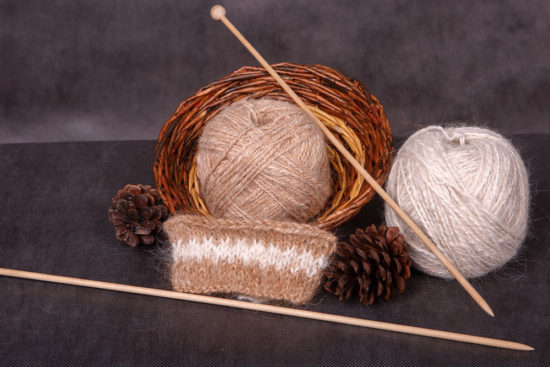Knitted items are coming back into fashion.
Today on the streets of the city you can see girls who are dressed both warmly and beautifully. Hats are no exception. Many different options can be invented and implemented. The stores have a wide range of different colors, compositions, and densities.

Tips on how to choose yarn for a hat for the winter
The first thing you need to pay attention to is compound.
Since a winter hat must be warm and not allow the wind to pass through, you should focus on mixed threads. Pure synthetics will not work, they are too cold, it is better to pay attention for wool with added fibers. So, the hat will be stronger, it is easy to wash, and it will not roll up during wear.

Also, when purchasing, you need to pay attention for twisting. The looser and airier the twist, the warmer the product.
By color There are no special recommendations, everything is at your discretion. There are many different colors available in craft stores today.
However, if you are new to the business, know that It’s better to buy melange thread. It has several colors twisted in it, so it will hide small defects that you may make due to inexperience.
Anyway First you need to choose a hat model. If the hat is from a magazine or catalog, then you can read recommendations for choosing yarn from there. They will even recommend the manufacturer. If not, decide what composition, thickness and texture of thread you need.
What yarn to knit a winter hat from - synthetic, blend or wool?
Now let's take a closer look at the types of yarn.
Synthetics consists of fibers that are obtained after strong chemical treatment. Types: acrylic, polyamide, polyester and others.
Pros of synthetics:
- reduced degree deformation. Durable threads hold their shape after repeated washings;
- cheaper natural fibers;
- great amount shades.
Minuses:
- ready product electrified;
- pure synthetics does not heat well;
- misses wind.
It is better not to use pure synthetics, without added wool, for hats.

Mixture – natural thread is mixed with synthetic fibers. Natural yarn only benefits from the addition of synthetics. For example, this is wool with the addition of acrylic, cotton with viscose, etc.
Pros of blended fibers:
- low price;
- ready product pricks less than pure wool;
- hypoallergenic;
- elasticity, easy to knit;
- does not deform during wear;
- after washing doesn't sit down.
The downside is that it doesn’t allow air to pass through well, which can make your head sweat a lot.
Wool – natural warm material. Threads are mainly made from sheep's wool.
Disadvantages:
- prickly. You need to do a yarn test on the skin;
- Only delicate, manual handling is acceptable wash. Machine washable at 30 degrees;
- may cause allergies;
- high price.
Types of wool in more detail

Alpaca — very warm, soft, does not cause allergies. There will be no pellets on the product. Doesn't get wet. The only negative is that the material is expensive.
Angora - warm, fluffy yarn. Hand wash only, otherwise the product will quickly deteriorate.
Cashmere – elastic, warm, easy to knit. Without addition, pure cashmere can stretch, so it is added to regular wool.
Hats from mohair will not let the wind through. The big advantage is that mohair is economical to use. Working with it will require some experience, because the fibers can get tangled.
Merino yarn – elastic, dense. Hypoallergenic, skin-friendly.
Yarn for snood

For snood, wool yarn with the addition of acrylic is suitable. Added synthetics will make wool more elastic and practical.
Pure synthetics will not allow the product to look neat. The yarn will roll up quickly, and after washing, even the most delicate one, the snood will stretch, and besides, it will also allow the wind to pass through.
A good ratio: 60/40 or 70/30.
Hat lining

It is worth thinking about the lining for the hat.
Suitable:
- fleece;
- thick cotton;
- cotton jersey.
Ideal yarn for a spring hat

Unlike winter, you can choose any yarn for spring. The main thing will still be color. If we are talking about the autumn-winter period, then this is a blend of wool yarn with the addition of synthetics. The latter may be greater in this ratio. If you have a light spring hat, then any synthetic thread will do.
Here we focus on the texture of the thread and color.
In this case, synthetic yarn is more suitable than ever. Because it does not fade in the sun, does not deform when washed, the material is easy to knit and wear. The product will be convenient and practical.
So, we looked at the main types of yarn of three different types: synthetics, blends and wool. All you have to do is choose which one is suitable for your type of product.
Be sure to do a wool test on your skin before purchasing. otherwise you won't be able to wear the product even if you really like it. Also knit a small piece and wash it in a machine, so you can understand how the yarn will behave.


 0
0





